Fishing Report: June 11, 2021

Red snapper bite is on fire offshore
Every Friday morning, Captain Dylan Hubbard of Hubbard's Marina joins Good Day to fill viewers in on his fishing forecast as we head into the weekend. Here is his fishing report for June 11, 2021.
MADEIRA BEACH, Fla. - Every Friday morning, Captain Dylan Hubbard of Hubbard's Marina joins Good Day to fill viewers in on his fishing forecast as we head into the weekend.
Here is his fishing report for June 11, 2021.
Inshore
Snook are stacked around the passes right now. We are seeing plenty of these guys around the dock lights, bridge lights, and in the early morning around structures as the sunrises.
During the day, there is plenty of snook action around the bridges, docks, piers, jetties and grass flats, and islands of the bays. Look for them along the beaches moving parallel to the beaches in those swash channels too.
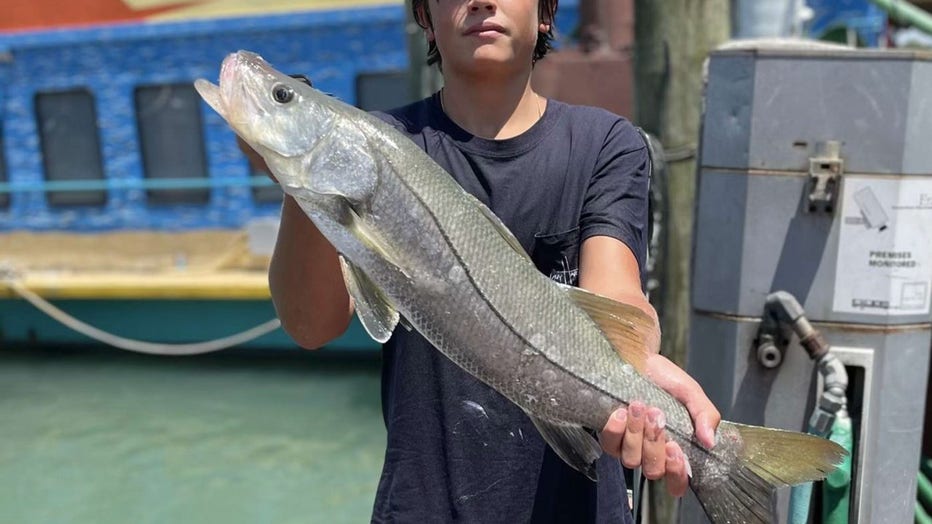
Snook caught inshore. (Credit: Hubbard's Marina)
At this time of year, the passes and beaches are where you can find plentiful snook. There’s still active fish in the bay but most are slot-size and under while the slot-size and larger-sized fish move into the passes and along the beaches.
Redfish bite is hot right now around the passes near the docks, bridges, and sandy edges. We are seeing a great redfish bite around the dock during the day especially when you ‘chum’ a bit with some fresh dead shrimp. The bottom is the best place to find them foraging for chunked dead bait or those shrimp or smaller crabs.
There is plenty of black drum mixed around in these areas foraging on the bottom too. The back bay has plenty of redfish action too around the flats, mangrove shorelines, and oyster bars.
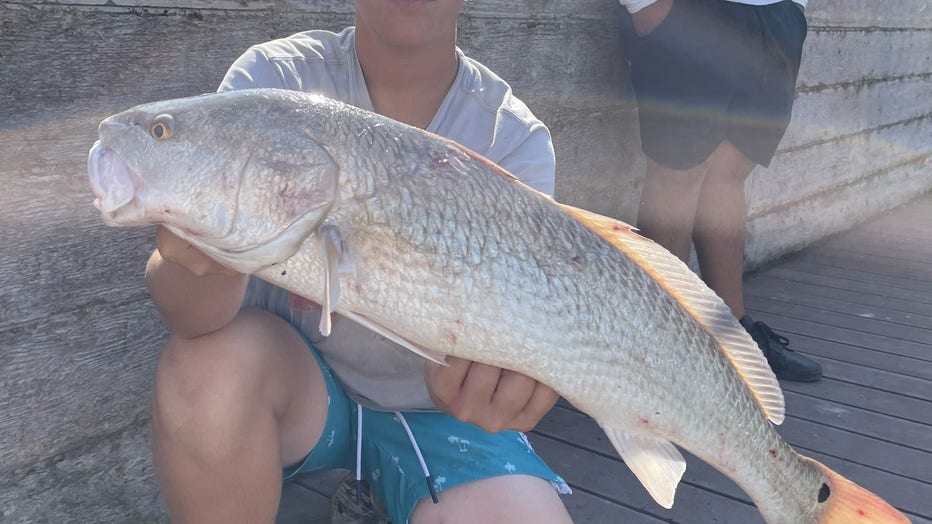
Redfish caught inshore (Credit: Hubbard's Marina)
Mangrove snapper are prolific around virtually any structures. We are seeing them around the rock piles, bridges, jetties, docks, seawalls, and virtually anything holding growth and attracting bait.
Trout bite is steady at this time around the passes at night on bridge lights and dock lights. During the early morning hours, just after the sun’s up, look from them around the beaches and flats. During the day, look for them on the deeper flats, edges of shallower flats, in those potholes, and cuts of the local grass flats too.
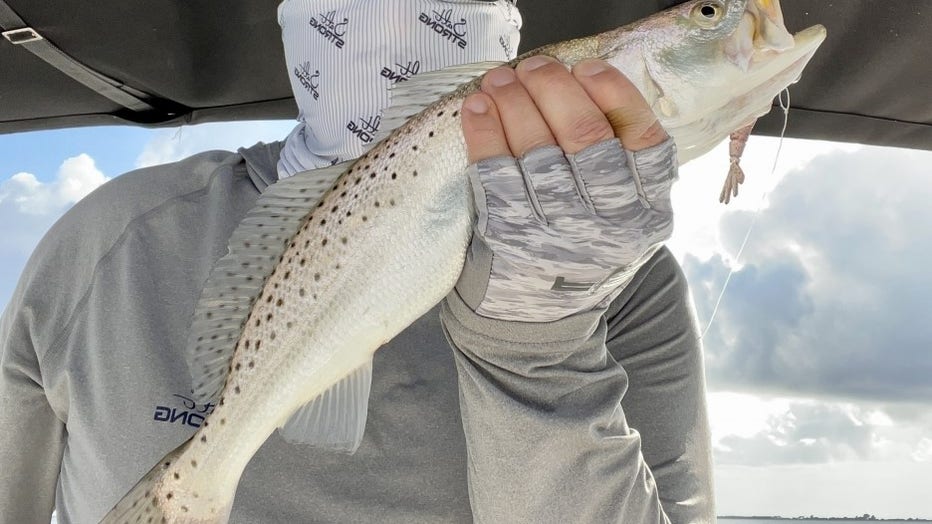
Trout caught inshore (Credit: Hubbard's Marina)
Tarpon are showing up in droves in your local passes, shallow sand bars, and moving up and down the beaches. There are some great tides through the weekend that should get the tarpon actively feeding. Those large new moon tides should flush some bait, crabs, and whitebait that should get big schools ready to chew.
Pompano bite is still occurring around local passes, the local bridges and along the beaches. Look for them in that sandy bottom area especially near the structures or channels where they can easily find bait to ambush.
Sheepshead are spread out and picky in the warmer waters, but still, plenty around the area. However, they get much less aggressive as the waters warm, and they spread out in quite smaller numbers.
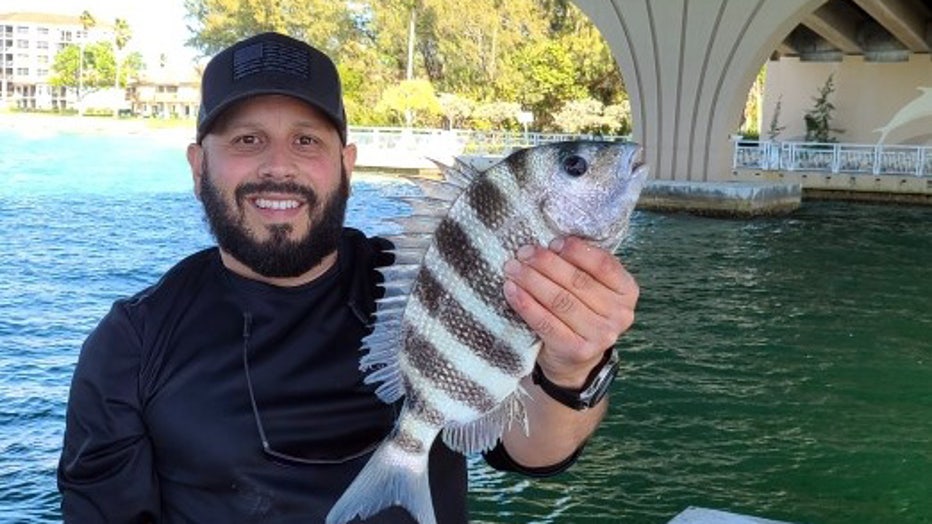
Sheepshead caught inshore (Credit: Hubbard's Marina)
Mackerel are still biting in the earlier morning hours along our local passes, jetties, and beach fishing piers. Look for these guys where bait is congregating, and water is moving.
Near shore and offshore
The red snapper bite is FIRED up offshore right now. They are open and in full swing for EVERYONE off the west coast of Florida in the Gulf of Mexico in federal waters.
The private recreational anglers from private boats are governed under the FWC private rec season from June 4 until July 28 with the likelihood of a possibly longer season with added days in the fall.
The federal-for-hire anglers aboard the charter boats and party boats with federal fishing permits have a little longer season to start with a June 1 opener that runs until end of day August 2, but there is no shot at the feds being able to even if our quota is not filled add more days in the fall.
This is the benefit to private rec anglers and their state-managed seasons if the council will act on the state data calibration issues that Alabama, Mississippi, and Texas are having. Luckily, Louisiana and Florida have state systems that closely align with their federal data counterparts.
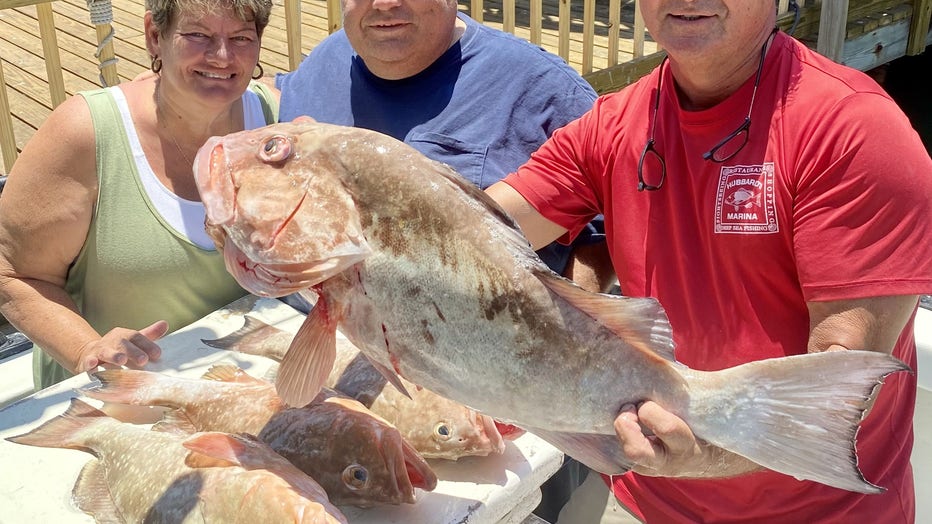
Credit: Hubbard's Marina
Florida private rec anglers will actually gain access and lengthened seasons if the council takes an equal approach by only penalizing the states with currency so off base, it requires a more aggressive currency exchange ratio.
State management has worked for private rec anglers and all the states have spent a lot of money and time developing their own state data collection systems. They have all been peer reviewed and approved. However, we have five state data ‘currencies’ that are all having to be measured against the federal data ‘currency’ that sets the ABC or acceptable biological catch.
This is the main issue: you cannot bring U.S. currency to Europe and use it. You must go to an exchange and they use a ratio to turn your USD into Euros. It is the same issue here. It’s just like the old saying: You cannot compare apples to oranges.
Well, the federal quota is set in oranges while each state has its own data collection system that measures in apples, pineapples, bananas, pears, and blueberries. So, we have to get all those customized data collection streams to a common currency through calibrations to ensure that the quota is not overfished. Currently, it’s being exceeded by a great deal and the council is struggling to find a data calibration solution.

Red snapper caught offshore (Credit: Hubbard's Marina)
Now, back to fishing. These red snapper are biting best in our area beyond around 140 to 160 feet of water. The deeper you go, the bigger and more prolific they become. We fished as deep as nearly 300 feet of water recently and the red snapper only got bigger and more concentrated as we got into deeper waters.
Big dead bait chunks are the hot bite right now for the red snapper, like the bonita, mullet, or mackerel. Virtually any large, oily fish are great options to fillet and then strip out to make great red snapper baits. Also, large squid strips or octopus tentacles are great options too.
We are seeing big red snapper on whole threadfins and even double threadfins as well. These guys are super aggressive, and we do not normally have the break-off issue so typically 60-80 pound leader is sufficient when targeting the American red snapper offshore.
Gag grouper are biting extremely well right now too for us out in deeper waters. We are seeing a few here and there near shore and actually more inshore around Tampa Bay. However, the bulk of the fish and especially the truly large gag grouper are well offshore due to the warmer water temperatures.

Gag grouper caught offshore (Credit: Hubbard's Marina)
When waters are hot, gags are in deeper cooler waters. When the water cools down and gets colder, they come in shallow areas. Right now, the best area to start looking for gag grouper is out there around 140 feet of water or more where we are targeting the red snapper.
Also, the gags are super aggressive as of late, loving the biggest live baits. We are seeing them fired up on the monster squirrelfish or big white grunts and even porgies too. The bigger and friskier the live bait, the more likely a bit ole gag will eat it up while offshore fishing with heavy tackle and big patience!
The trick to gag grouper fishing is having an exceptionally large reel with minimal 45 pounds of drag ore more and at least 80-100lb test and a very large live bait requiring an 8-10ot hook or more. Really, that 2-3lb bait and that 12-14ot hook, 125lb leader, and that big 9ot equivalent reel is what will get you that trophy gag grouper.
Mangrove snapper fishing is going well for us right now too. We are seeing active mangrove snapper around 70-100 feet of water near shore and virtually all over the offshore waters. It’s a great time to target mangroves if you can get past the red snapper or stay inside of them in shallower waters under 110-120 feet of water.

Mangrove snapper caught offshore (Credit: Hubbard's Marina)
However, while out deep, targeting them at night and avoiding that high-water column ‘Christmas tree’ shows of red snapper is a great way to get on a good bite of mangrove snapper. We are catching them most often on that threadfin chunk with around 60lb leader out deep and 40lb leader in closer.
However, fishing beyond 100 feet of water, you do not want to lighten up your leader more than around 60lb. So, you have that shot at a gag if he happens to take your smaller chunked threadfin while the gags are open.
Yellowtail snapper are biting well for us right now too, especially while fishing out deeper for these bigger American red snapper. Around 120-160 feet of water and beyond, the yellowtail starts to get prolific, and like the red snapper, the deeper we got, the likelihood of bigger yellowtails become more and more common.
Lane snapper closer in the near shore waters are super-hot right now with some bigger more consistent fish around 80-100 feet of water. But we’re seeing them as deep as 120 feet of water in good numbers and as shallow as 60 feet in decent numbers too.
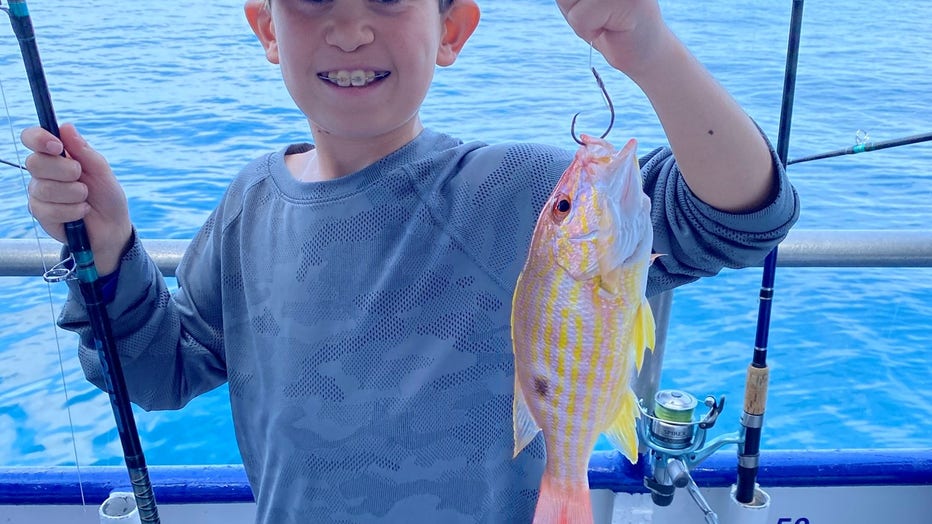
Lane snapper (Courtesy: Captain Dylan Hubbard)
Pelagic action is super crazy right now. The opportunity for passing chicken dolphin schools is ever-present. Plus, we are seeing sailfish out there fairly often plus plentiful kingfish and blackfin tuna.
Wahoo are also around this time of year as well. It is imperative you remember your flat line and do not forget to set it and watch for it while tearing up the red snapper and gags this summer, especially when fishing beyond 120 feet of water.
Those mahi mahi will also swim nearshore too with some decent schools spotted as shallow as around 35-40ft of water.
DON’T BE A FOOL, bring a venting tool & Descending device
Keep in mind the importance of dead discards and discard mortality when engaged in near shore or offshore fishing. How many do you know right now that are all for catching and releasing snook, redfish and trout but will be the first in line to kill a mangrove snapper, gag grouper, or red snapper? But the attitude completely changes when discussing these offshore species?
Plus, the same person inshore that will hold their breath and wet their hands before handling a breeder snook will go offshore and then cull through 20 red snapper before keeping their two red snapper they deem large enough to fill their two-fish bag limits. Meanwhile, the other 18 they released will often end up suffering fatal damage if not properly descended or vented?
Please help us to spread the word on the importance of descending or venting your released fish. Descending devices are most easy to use and quick to pick up on their use. They are most effective for most anglers.
However, an expert and precise angler with proper training and tons of experience can use a venting tool properly with similar outcomes. A venting tool requires you to pierce the fish while most descending devices are much less invasive. While using a venting tool, it is imperative you pierce them in the exact right spot, and you do not go but a quarter-inch or less in the fish. Most venting tools require you to ‘choke up’ on the tool to prevent over-penetration into major organs.
When fishing deep water, especially in the hot summer months, please make sure to treat all fish intended to be released like that breeder snook inshore and minimize the time it takes you to get him from the bottom to the boat using heavier proper tackle, not an ultra-light spinning reel.
Then once onboard, minimize the time out of the water. Then use a proper de-hooking tool and then, for the love of God, use a descending device or venting tool PROPERLY to ensure that fish has a chance to live another day.
Three things will help ensure the survivability of those fish released offshore:
- Making sure they are brought up quickly and do not expend all their energy in the fight.
- Make sure they are unhooked smoothly, easily, and as quickly as possible.
- Finally, make sure they spend the least amount of time at the surface at negative pressures where barotrauma exponentially increases its effect with each passing second.
Also, keep in mind when the water is warm, there is less dissolved oxygen content and the chances of barotrauma increase even more while its effects can be even more deadly.
LINK: Here’s all the information and more on barotrauma and how to mitigate that fatal damage to your future offshore catch
**Note: I recommend the Salt Strong articles at the bottom of the page under ‘webpages.’ I helped them develop those personally.
STATE SURVEY to improve recreational data and access
It is imperative that you have your Gulf Reef Fish survey endorsement on your fishing license.
You should get one if you are a private recreational angler or diver fishing from a private boat anywhere in Florida who intends to harvest, attempt to harvest or possess one or more of the following reef fish species: mutton snapper, yellowtail snapper, hogfish, red snapper, vermilion snapper, gag grouper, red grouper, black grouper, greater amberjack, lesser amberjack, banded rudderfish, almaco jack, gray triggerfish, Gag grouper, Red grouper, Scamp grouper, Mangrove snapper, Lane snapper, Kingfish, Tuna, or Mahi mahi.
Here is all the information and more on that program and how you can sign up.
TERMS OF REFERENCE:
INSHORE – from the back bays out to the bridges and including right on the beaches
NEAR SHORE – From the beaches out to 20 miles, or up to 100ft of water
OFFSHORE – from 20 miles or 100ft and beyond

